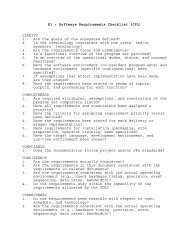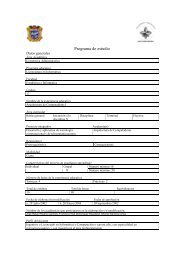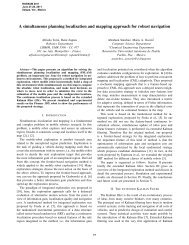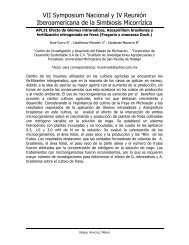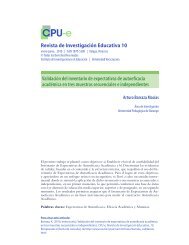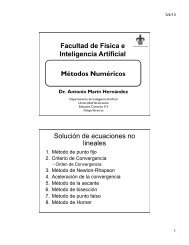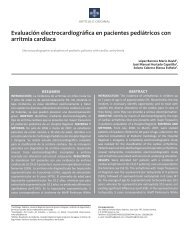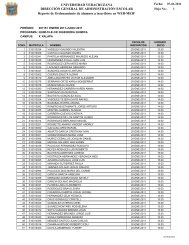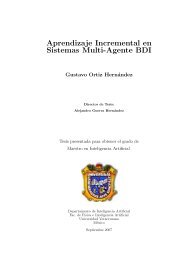Understanding the Software Options
Understanding the Software Options
Understanding the Software Options
Create successful ePaper yourself
Turn your PDF publications into a flip-book with our unique Google optimized e-Paper software.
FOCUS ON<br />
Rupture Discs and<br />
Pressure Relief<br />
The lowest K R values in<br />
rupture discs<br />
K R values are used to determine<br />
<strong>the</strong> frictional flow<br />
loss in rupture discs. While<br />
<strong>the</strong> perception is that all rupture<br />
discs have high K R values,<br />
this company’s FAS (Forward Acting<br />
Scored; photo) and PRO+ (Precision<br />
Reverse Operating) discs debunk this<br />
perception by offering <strong>the</strong> best flow<br />
characteristics available in a rupture<br />
disc. Having a lower K R value means<br />
that <strong>the</strong> FAS [K RG = 0.223 (gas), K RL<br />
= 0.19 (liquid)] and PRO+ (K R = 0.29)<br />
rupture discs provide a larger opening<br />
that allows a greater flowrate than<br />
o<strong>the</strong>r rupture discs on <strong>the</strong> market,<br />
says <strong>the</strong> company. The ability of <strong>the</strong>se<br />
two discs to reach such low K R values<br />
allows for better flow and faster system<br />
relief in <strong>the</strong> event of overpressurization.<br />
The FAS and PRO+ are both<br />
used for safety-relief valve isolation.<br />
The FAS is used in high-pressure applications,<br />
while <strong>the</strong> PRO+ is ideal<br />
for situations requiring a lower burst<br />
pressure. The PRO+ is also suitable<br />
for isolation relief valves in high-cycling<br />
applications. — Oseco, Broken<br />
Arrow, Okla.<br />
www.oseco.com<br />
A system that manages all<br />
overpressure relief devices<br />
This company has introduced Relief<br />
Device Manager (RDM; photo) for<br />
optimizing <strong>the</strong> safety, integrity and<br />
total ownership of overpressure relief<br />
devices, including rupture disks;<br />
buckling-pin relief valves; safety and<br />
pressure-relief valves; tank vents;<br />
flame arrestors; and explosion vents.<br />
This Windows-based system provides<br />
peace of mind to plant operators and<br />
owners by continuously monitoring<br />
overpressure relief devices. RDM provides<br />
warnings, alarms and performance<br />
history if events compromise<br />
<strong>the</strong> integrity of pressure safety management<br />
systems. RDM was designed<br />
because overpressure relief devices,<br />
such as rupture disks, activate instan-<br />
Fike<br />
48 CHEMICAL ENGINEERING WWW.CHE.COM AUGUST 2011<br />
BS&B Safety Systems<br />
taneously, which presents<br />
challenges to process plant<br />
owners and operators in<br />
pinpointing precise<br />
operating conditions<br />
of an overpressure<br />
event. Without RDM,<br />
inaccurate conclusions<br />
regarding <strong>the</strong><br />
relationship between process<br />
conditions and overpressure relief<br />
devices can be made, risking repeated<br />
incidences and compromised safety.<br />
Inaccurate conclusions are frustrating,<br />
if devices are bursting frequently<br />
without <strong>the</strong> ability to diagnose causes,<br />
or if you are trying to maximize longevity<br />
of overpressure relief investments<br />
through precise replacement<br />
schedules. — BS&B Safety Systems,<br />
Tulsa, Okla.<br />
www.bsbsystems.com<br />
Reverse-acting rupture discs for<br />
aggressive, sanitary applications<br />
The Axius reverse-acting rupture<br />
(bursting) disc (photo) is said to represent<br />
a revolutionary advancement<br />
in high-performance pressure-relief<br />
technology. The manufacturer has<br />
continued to expand Axius capabilities,<br />
since its introduction in 2005,<br />
by offering higher burst pressure, a<br />
sanitary version and a range of larger<br />
sizes. Axius is designed to be used in<br />
aggressive chemical, pharmaceutical<br />
and sanitary applications, and typically<br />
outperforms all o<strong>the</strong>r types of<br />
rupture discs in <strong>the</strong>se applications,<br />
says <strong>the</strong> company. Axius rupture discs<br />
are unique because <strong>the</strong>y have no score<br />
lines, no stress zones that can fatigue<br />
Oseco<br />
and a completely smooth<br />
process side. — Fike Corp.,<br />
Blue Springs, Mo.<br />
www.fike.com<br />
Micro-scored rupture discs offer<br />
added benefits<br />
This company has recently introduced<br />
its SCD (forward acting) and SCR<br />
(reverse buckling) rupture discs with<br />
micro-scored calibration sections. The<br />
patent-pending technology makes <strong>the</strong><br />
discs very flexible so that scoring in<br />
six or more sections is possible instead<br />
of <strong>the</strong> usual four. This allows a better<br />
opening of <strong>the</strong> disc, reducing <strong>the</strong> risk<br />
of petal detachment, even at higher<br />
pressures, says <strong>the</strong> company. This<br />
technology is also very effective for <strong>the</strong><br />
manufacture of high-performance reverse<br />
buckling discs for low-pressure<br />
bursting ranges. The discs react to excessive<br />
pressure in a few milliseconds<br />
without fragmentation, have a good resistance<br />
to corrosion and are especially<br />
suitable for protection of relief valves.<br />
The company has also recently tested<br />
new materials for rupture discs, such<br />
as titanium and tantalum. — Donadon<br />
SDD Srl., Corbetta, Milan, Italy<br />
www.donadonsdd.com<br />
Proportional venting assured<br />
with <strong>the</strong>se relief valves<br />
RHPS Series PRV model proportional<br />
relief valves (photo, p. 56) provide<br />
Note: For more information, circle <strong>the</strong> 3-digit number<br />
on p. 54, or use <strong>the</strong> website designation.



